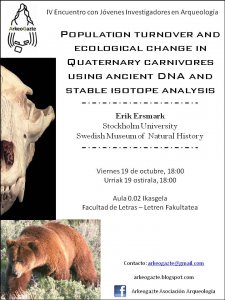2012/10/19 Erik Ersmark
Stockholm University/ Swedish Museum of Natural History
The dramatic climate changes of the Late Pleistocene as well as the increasing human domination in the Holocene have had significant effects on many large mammal species in the northern hemisphere. These effects can both be traced in the range, ecology and genetic diversity of present day populations, as well as through the study of ancient DNA. The latter have enabled comparisons to be made with a time scale up to the past 50,000 years, revealing population turnover, range shifts and local extinctions in the distant past. My PhD-project aims to investigate these population dynamics and their causes, using one of the most widespread carnivores in the Holarctic today, the brown bear (Ursus arctos), as a model species. By studying both relatively modern as well as ancient remains I hope to compare genetic diversity on a large time scale. Stable isotope analysis will also be performed on the remains, in order to study long-term changes in the ecology of the brown bear.

